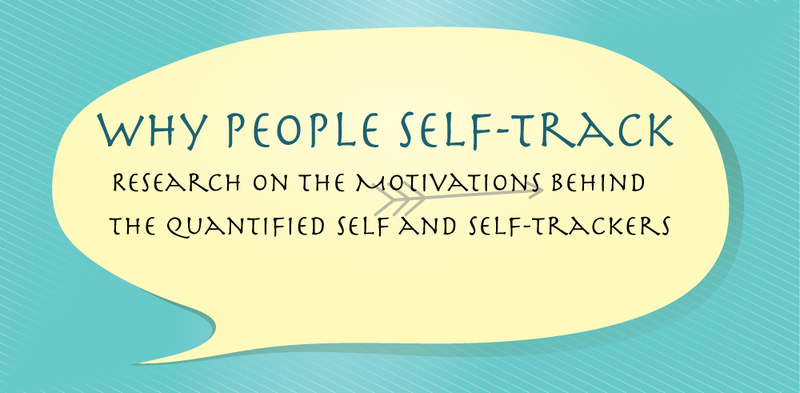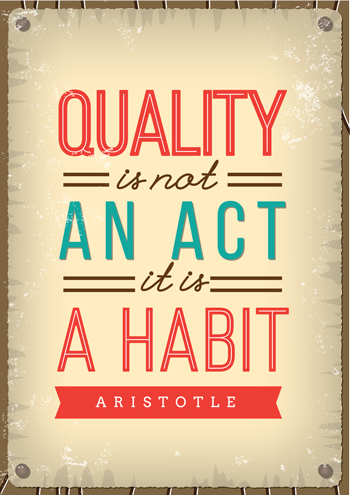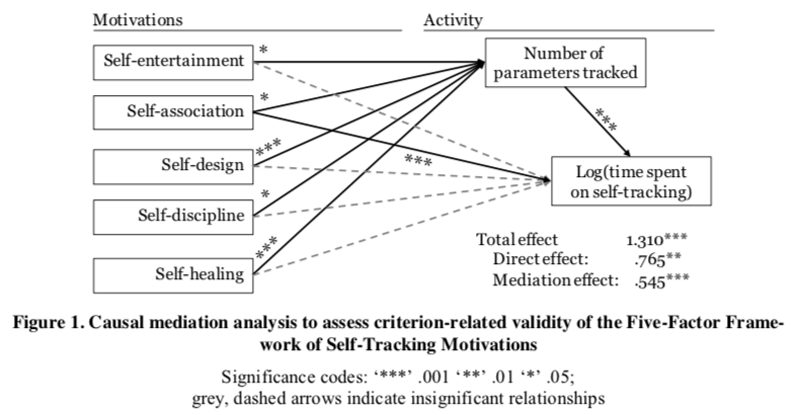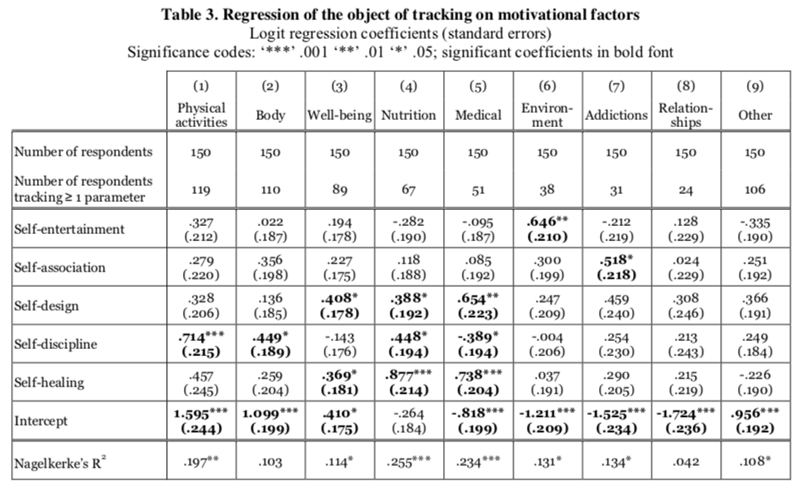
According research in 2016, sociologist Deborah Lupton estimates that there are well-over 160,000 tracking apps available in the app stores, including both for Android and Apple phones. This includes both explicitly tracking apps like Nomie and PhotoStats.io and various health and wellness apps like Strava and RunKeeper.
While we have yet to see a ubiquitous world of activity trackers, there are also dozens of wearables devices today like the Fitbit, Garmin, Jawbone UP, Nike+ Fuel, MiBand, and Apple Watch as well as dozens of other targeted devices and tools for quantifying your health and fitness.
Tracking and personal observation date back centuries. You can find strands of self-improvement through self-examination in both Ancient Greek and Ancient Chinese philosophers. Proceeded by the confessional writings of Saint Augustine of Hippo and Jean-Jacques Rousseau, the Victorian era was notable for the proliferation of personal diaries and journals, which allowed for a narrative format of self-reflection. Today’s digital age has not really changed the human quest, to borrow a phrase, to know thy self. We simply have more more tools and manners, both passive and active, to track our body, mind, time, environment or whatever. In short, it’s easier than ever to track a life.
Several centuries after Socrates declared the “unexamined life not worth living” is its digital equivalent, the “Quantified Self,” a neologism, a meetup, a movement and a life philosophy, whose tagline is “self-knowledge through numbers.” Considered one of the founders of QS, Gary Wolf is also one of the most active writers on the topic. His piece, The Data-Driven Life in the New York Times in 2010, captures the core of what self-trackers are pursuing as well as how diverse and divergent the QS movement is.
For example, one aspect is a technologically infused attempt at understanding human behavior. As he writes, “Ubiquitous self-tracking is a dream of engineers. For all their expertise at figuring out how things work, technical people are often painfully aware how much of human behavior is a mystery.”
As a journalist at Wired, Wolf has been chronicling the QS movement and its characters for nearly a decade. He subscribes to the idea that what today’s self-trackers are doing is not that different than what humans have been doing for centuries: personal observations. A few things have changed though. As he puts it:
Four things changed. First, electronic sensors got smaller and better. Second, people started carrying powerful computing devices, typically disguised as mobile phones. Third, social media made it seem normal to share everything. And fourth, we began to get an inkling of the rise of a global superintelligence known as the cloud.
Quantified self enthusiasts, self-trackers and just curious technologists can now leverage technology to deepen and widen their ability to observe and quantify themselves. But that still begs the question: Why do people track? Why Self-Tracking? Why pursue a quantified self?
In this post, I want to explore what motivates people to track their lives. Whether it’s a quantified self adherent or simply someone tracking their weight, health or fitness, a lot of people are tracking their lives today, and there hundreds of ways to do it. To help understand the space more, we will look the general categories tracking falls into. We will then look at a couple of research papers that attempt to survey and define the QS and self-tracking community. The goal of these papers is to understand what motivates someone to pursue self-tracking and create their self-tracking projects and experiments.
A Note About Terms
The terms, self-tracking, lifelogging, quantified self, and personal data, are in most cases synonymous. They generally refer to the same thing: the activity of recording something about a person’s life. Personally, I prefer the term “self-tracking” over the others since it feels the most expansive and most self-explanatory. In this post, I use these terms interchangeably.
I define “self-tracking” as the activity of measuring or documenting something about your self.
This definition intentionally excludes anything about what motivates someone to track. The reality is that different people and different types of tracking have different objectives. As we will see in this post, most self-tracking is done to gain meaning or to make improvements, but seems to also have a significant connection with the conscious engagement and understand of technology in human lives today.
How People Track: Examples of Quantified Self and Self-Tracking

The most common examples of self-tracking are health and fitness. This means biometric data, health indicators and vital signs like blood pressure, heart rate, calories consumed, distances walked, run, cycled, or swam, hours slept, and even weight. These tools often look at biomarkers, which are signs that indicate disease or wellness and can be done with blood tests and even some bodily sensors. There are also many period, fertility, and pregnancy tracking apps for women. Fitness and health tracking, though often conflated, appear to be the most actively tracked areas. Broadly speaking, these health apps
Besides the physical, there are also hundreds of apps to track our psychological side too. You can find dozens of apps to record mood, emotions, stress, energy level, and more. Self-tracking isn’t limited to health metrics either. You can find ways for tracking your location, movements, driving, travel, etc. There is a wealth of apps to quantify your time, like computer and mobile usage, productivity, and project time.
In order to help organize and promote the best tracking, for the past couple years, I’ve helped maintain the Awesome List on Self-Tracking and Quantified Self. Awesome lists are basically curated lists of great resources on a certain topic, and they are a great place to start when you want to learn anything new or find new things to work on from topics ranging from technology and programming to even health and video games. For QS, we’ve provided the best starting place for anyone interested in getting started.
While there might be, as sociologist Deborah Lupton estimates, a hundred thousand or more tracking apps available today, we categorize quantified self services into two broad divisions: apps and wearables. Wearable are targeted things you put on your body to track specific parameters and includes activity trackers, smart watches, smart textiles and more. Smart phones are mini computers we carry around and provide a lot of opportunity for tracking.
We currently divide tracking apps into the following 16 general categories:
- Activity & Fitness
- Data Collection
- Diet
- Goals
- Habits
- Health
- Heart
- Media Consumption
- Mind & Cognition
- Mood
- Sleep
- Tally
- Time
- Wealth or money
Besides these area-specific categories, there are two other categories worth mentioning:
- Aggregators & Dashboards: These are sites and apps that pull together data from various tracking sources into a unified view and often provide visualizations and correlations.
- Automation: These are tools that typically use events from one tracking service to trigger an action or reaction into another service. For example, when I complete a run in Strava, I can post my run log into google sheets or into a chat program like Telegram.
A full breakdown of these categories and the various examples of tracking goes beyond this post, but I encourage you to read and explore the various links at our quantified self awesome list at https://github.com/markwk/awesome-quantified-self. In general, if you are just getting started with personal tracking, I recommend picking one category and a single app initially.
Why Do People Track?: What the Research Says

I’ll admit that my reasons for tracking might not be why you or someone else tracks. My motivations might not convince non-trackers to start tracking either. But before I share why I track and conclude with a few reasons to try and convince why you should track your life (at least in some small yet consistent ways), let’s examine why people track.
In a 2010 TED talk on Quantified Self, Gary Wolf explained that when him and Kevin Kelly, another writer at Wired Magazine, held their first Quantified Self meetup in 2007 they were not really sure what they were doing. They weren’t particularly interested in the growth of social media on sites like Twitter and Facebook. They were technologists, so instead they decided to setup an experimental gathering to see how people were incorporating technologies into their lives and what changes in society this adaptation was causing.
During their first impromptu event of about 30 people, they were wowed as the first participant shared how he used technology to track and collected data to better understand a project he was working on. Here’s how ethnographer Butterfield retells it:
The late comer, turned out to be a graduate student in Human Computer Interaction, who had been tracking detailed data on how he was spending his time during the year he spent writing his dissertation. He walked up to the front of the room, opened up this notebook computer and showed a graph that represented data he collected. Wolf and Kelly were stunned. This was the perfect beginning presentation for Quantified Self. They had guessed that this kind of application of technology was going on, and by accident, they had found it. The personal story of this time tracking project was exactly the kind of thing they were hoping to find.
This first talk become the inspiration for a core element of QS meetups: the show and tell. Basically participants share something they tracked, how they tracked and what they learned.
Regarding the motivation to start QS, Wolf explained that it wasn’t to launch a movement but to simply explore people and technology. Since their first meetup, QS has grown to cities all around the world, and as we saw in the previous section, dozens of apps and wearables have also appeared to help track our bodies and lives in general.
This Google Trends comparison of the search terms, self-tracking (blue), lifelogging (red) and quantified self (yellow), shows rise of quantified self in early 2010 to a peak in 2014:
![]()
While the specific terms may have lost their popularity, the ubiquity of tracking apps shows that the usage of self-tracking remains just as popular today. In the academic realm, there are over 800,000 academic articles, according to Google Scholar, that reference “quantified self” as well as multiple books and conference dedicated to the topic too. There are a lot of people tracking and quite a few people also writing and reflecting on self-tracking. So what do we know about why are people tracking their lives?
In a short piece “10 Reasons Why People Self-Track,”, Eric Jain, tech entrepreneur and creator of Zenobase, an aggregation and data analysis tool of self-tracking data, provides the following reasons for why people track: Curiosity, DIY, Education, Fashion, Fun, Hacking, Motivation, Necessity, Skepticism, and Social.
If we look at the academic research, there are two papers that seem to provide the best starting point for understanding motivation of self-trackers: Butterfield’s “Ethnographic Assessment of Quantified Self Meetup Groups” (2012), and Gimpel’s paper, “Quantifying the Quantified Self: A Study on the Motivations of Patients to Track Their Own Health” (2013).
Let’s look at these two papers one by one to understand some of what motivates someone to track.
Butterfield’s “Ethnographic Assessment of Quantified Self Meetup Groups”
While perhaps not the most rigorous of studies and more focused on organizers rather than trackers, Butterfield’s paper, which is available on the QS blog, provides an interesting and early portrait into the founders and organizers of QS meetups.
As he states it, Butterfield’s “general goal was to understand the following questions: Why do different organizers start groups? What are the challenges and barriers organizers have been encountering? What are the points of innovation are occurring in the groups?” He then goes through multiple stages of interviews with organizers in order to understand how they put together events and what works best for them.
Butterfield provides his own definitions, namely:
self-tracking, is a set of practices that members of QS undertake. Self-tracking can take many forms, but generally is any deliberate, methodical project focused on some aspect of a person or the world they live in, in order to generate data that can potentially be used for self-improvement.
Additionally, he notes:
The name Quantified Self came about in an effort to describe this new frame. “Quantified” is the technology piece. Quantified in this sense means “the language of machines,” and refers to both the processes of the machines and the “language” machines use to convey information to users. This information can be numbers, raw data, or representations of data, like graphs and charts. “Self” refers to the person, and whatever aspect of the self is under examination.
Butterfield goes on to share various other motivations he finds from trackers and organizers like:
- “potentially make lifestyle changes based on these data”
- “what it means when people use the technology”
- “personal and social meanings of technology”
- “From the beginning, the intended focus of QS was on how people are using new technologies, how they are incorporating them into their lives, and the changes that occur.”
What we find throughout the piece is examination of a particular form of a “techno-culture.” For Butterfield, “the most important insight is that QS is not a monolithic community where everyone involved shares the same ideas about, and interests in, self-tracking,” and in fact, there are tensions in the group, like around whether what some trackers are doing is science or not and the value of quantitative vs quantitative data.
In the section, “The practice of self-tracking,” Butterfield attempts to categorize what’s going on with self-trackers. As he writes, “Grouping by domain, such as sleep or weight, is one way to describe self-tracking practices. However through my research, I identified three axes that can be used to describe or locate self-tracking projects within the spectrum of these phenomena.”
These three axes are:
- “technological involvement,” i.e. how much does the project rely on technology, devices, laboratory tests and sensors or can it be done with simple paper and pencil?
- “level of complexity in the design of the self-tracking project,” i.e. these projects might be called “self-experiments” since they rely on a more rigor or scientific method of collecting data, testing hypotheses, and exploring correlations.
- “goal driven or exploratory,” i.e. is the project driven by a life change or self-improvement? Or it mostly about simply exploring and more general understanding?
Here’s the figure that provides a way to visualize these three axes:
![]()
In summary, the majority of Butterfield’s paper explores the mechanics of the actual meetups and some of the challenges organizers face, specifically like finding a venue and getting attendees. He even provides useful recommendations to help existing and future organizers. What’s interesting in understanding what motivates a self-tracker is this non-domain specific conceptualization of self-tracking projects. Instead of saying it’s a health project or productivity project, we can view trackers and their efforts according to how much technology is involved, how complex the project is, and how much it is driven by goals or exploration.
Gimpel’s paper, “Quantifying the Quantified Self”
At the start of their 2013 paper, researchers Henner Gimpel, Marcia Nißen, and Roland Görlitz note, “Duggan (2013) estimates that already 69% of U.S. adults track health indicators for themselves or loved ones and one in five thereof uses technology to do so.” Compared to Butterfield’s work, which focused more on the community, their paper take a much more expansive and rigorous approach to understanding why individual track their lives.
Specifically they did a multi-stage interview of 150 individuals:
Age ranges from 14 to 76 years with mean 34 and median 30 years. 71% of respondents are between 20 and 40 years old. 58% are male, 37% female (5% did not disclose their gender); 41% are employed, 33% students, 17% self-employed, 9% other; 53% are from Europe, 39% from North America, 8% other.
A few points stood out to me:
- “Respondents track 1 to 39 parameters (mean 9, median 8), mainly on physical activity (e.g., exercises, steps), body (e.g., weight, heart rate, blood pressure), well-being (e.g., sleep time and quality, mood), nutrition (e.g., calories intake and balance, water consumption), and medi- cal issues (e.g., symptoms of chronic diseases, blood-test results, medication).”
- “One third of our respondents suffer from a chronic disease.”
- “Concerning the question, why they started tracking in the first place, 56% agreed that “they just thought they should” start self-tracking. Only 28% “have heard about QS before”, 7% are influenced by “friends that started doing so as well” and 8% have been asked by their physician to start tracking”
The researchers “followed the methodology described by Hinkin (1998) with six consecutive steps: (1) item generation, (2) survey administration, (3) initial item reduction, (4) confirmatory factor analysis, (5) further construct validity assessment, and (6) replication. The last step is left for future research.”
Following the initial surveys, they then used a statistical method called Principal Component Analysis (PCA), which is a way to convert a set of observations and possibly correlated variables into a set of uncorrelated variables called the principal components. Essentially they gather a wide range of stated motivations and then converted into a unique set. Ultimately this lead to five englobing motivations.
Compared to Butterfield’s analysis which broken self-tracking projects into three axes with the principle motivation axes based on whether the project was goal driven or exploratory, Gimpel’s Five-Factor Framework of Self-Tracking Motivations identified five principal reasons behind why people track their lives:
- self-healing = becoming healthier
- self-discipline = rewarding aspects of it
- self-design = control and optimize “yourself”
- self-association = associated with movement
- self-entertainment = entertainment value
This figure summarizes the findings:

Of the five motivations, individuals showed the highest adherence to self-healing and self-design. The researchers noted anecdotally that those motived by self-healing were often had “a certain rebellion against the healthcare system” and looking for alternative therapies too.
When it comes to self-design, trackers are often pursuing control over their lives: “No matter whether it is a self-tracker’s health, fitness, or mood, generally self-trackers are fascinated by the idea of controlling the way they are living by taking responsibility and optimizing their own lives.”
Accordingly there is a relation between the number of motivations people subscribe to and how much they track: “Data shows that more motivation on a single factor leads to increased tracking activity and, in addition, motivation from different factors is cumulative.” Basically when you have multiple motivations and stronger motivation of a specific factor, the result is an increase in the number of areas you track and amount of time you spend tracking.
Taking a step back, what does this mean for an individual tracker or for someone building a tracking app or tool?
For an individual tracker, you can start by asking yourself which of these five factors motivates you. If you find you have a vague interest in tracking but aren’t very disciplined than most likely you have little adherence to the key motivations. Similarly, if you track a lot of factors, like I do, there is a good chance you multiple motivations and interests that keep you involved and trying new experiments.
If you have built or are thinking about building a product or service that has a tracking component, this research can be useful too. Specifically you can use this research to think about how your tool needs to fit into one or two of these key motivations. As Gimpel puts it:
A system or service engineer trying to motivate tracking of well-being (model 3), nutrition (model 4) or medical aspects of daily live (model 5) will be most effective when appealing to a combination of Self- design and Self-healing.
In summary, people track their lives in various ways and for various reasons, but as this research shows various motivations can be reduced to a five-factor framework with the two most popular reasons being self-healing and self-design.
Conclusion: What the Research Says on What Motivates the Quantified Self and Self-Trackers
With well-over 160,000 tracking apps for smart phones and dozens of wearables, there are a lot of ways to track a life. Examples of quantified self and self-tracking spans a number of categories from Activity & Fitness, Health, Heart, Diet, Sleep, Mind & Cognition and Mood to Goals, Habits, Tally, Time. You can track your media consumption like TV, music listening and even podcast listening and there is a whole area for general data collection or lifelogging too. In short, it’s easier and more accessible than ever to track ourself. But with all of these ways and tools to track, it still begs the question: What motivates someone to track their life? Why self-track?
In this post, we look at a research papers that probed this question. At the origin of the Quantified Self movement we find a number individuals like Gary Wolf who were motivated by idea of using tracking to understand their engagement with technology as well as to try use technology to mediate our understanding of human behavior. We are a technological society, and we can use technology to help us better understand ourselves and our relationship with technology. Personally I find a lot of my engineering friends who track are motivated in some way by their general interest in playing and engaging with technology.
By looking at two research papers about Quantified Self from the perspective of organizers and trackers in general, we were able to come up with two frameworks for conceptualizing aspects of the QS movement. Butterfield’s research provide us with three axes to place self-tracking projects: technological involvement, level of complexity, and goal driven vs. exploratory.
At present, Gimpel’s Five-Factor Framework provides the best way to conceptualize what motivates self-trackers, namely: self-healing, self-discipline, self-design, self-association, and self-entertainment. Basically, is the tracker motivated by getting healthier? is it fun? is it because they are part of a group? Do they track to enforce a regime or process? Or is it part of a broader effort to control their lives?
Personally I find Gimpel’s framework encapsulates the major aspects of what motivates me to self-tracking. Originally, I started tracking my time and productivity, because I was looking to gain more understanding of how I worked best. This touched on aspects of self-design. Over the last few years I become much more motivated by my health and tracking my blood biomarkers and fitness routine become a good way to pursue self-healing and more extended way of enacting self-discipline too. While I like that there is a community and term like QS, it’s not a particularly strong adherence for me. I do find there is an entertainment value for me though.
I find it interesting that Gimpel uses of “self” in each of these terms. Admittedly, there is a thread of narcissism in the QS and quantified self movement. But personally I find that one aspect that motivates me in self-tracking is possibly of extending my personal data into broader citizen science. Specifically I think that as we get more and better data from a wider range of people, we can start to model that data to understand trends in health, happiness and general improvement. Basically self-tracking can lead to a better understand what it means to be human.
This somewhat non-self aspect motivates me to self-track and build thing in the tracking space too.
In short, while many track for personal or “self” reasons, potentially behind this pursuit of self is a pursuit of understanding humans and society too. We don’t just track for our-self but also for our-selves
Why do you track? What motivates you to track a life?
Sources:
A. D. Butterfield. “Ethnographic Assessment of Quantified Self Meetup Groups.” (2012): Accessed May 7, 2018, 2018. http://quantifiedself.com/wp-content/uploads/2012/05/Adam-Project-Report-5-17.pdf.
Gimpel, Henner, Marcia Nißen, and Roland Görlitz. “Quantifying the Quantified Self: A Study on the Motivations of Patients to Track Their Own Health.” (2013). International Conference on Information Systems (ICIS 2013): Reshaping Society Through Information Systems Design
Wolf, Gary. “The Data-Driven Life.” The New York Times 28 (2010): 2010.
Appendix of Additional Figures:
Regression of the object of tracking on motivational factors

Correlation of motivational factors and personality traits:
![]()
